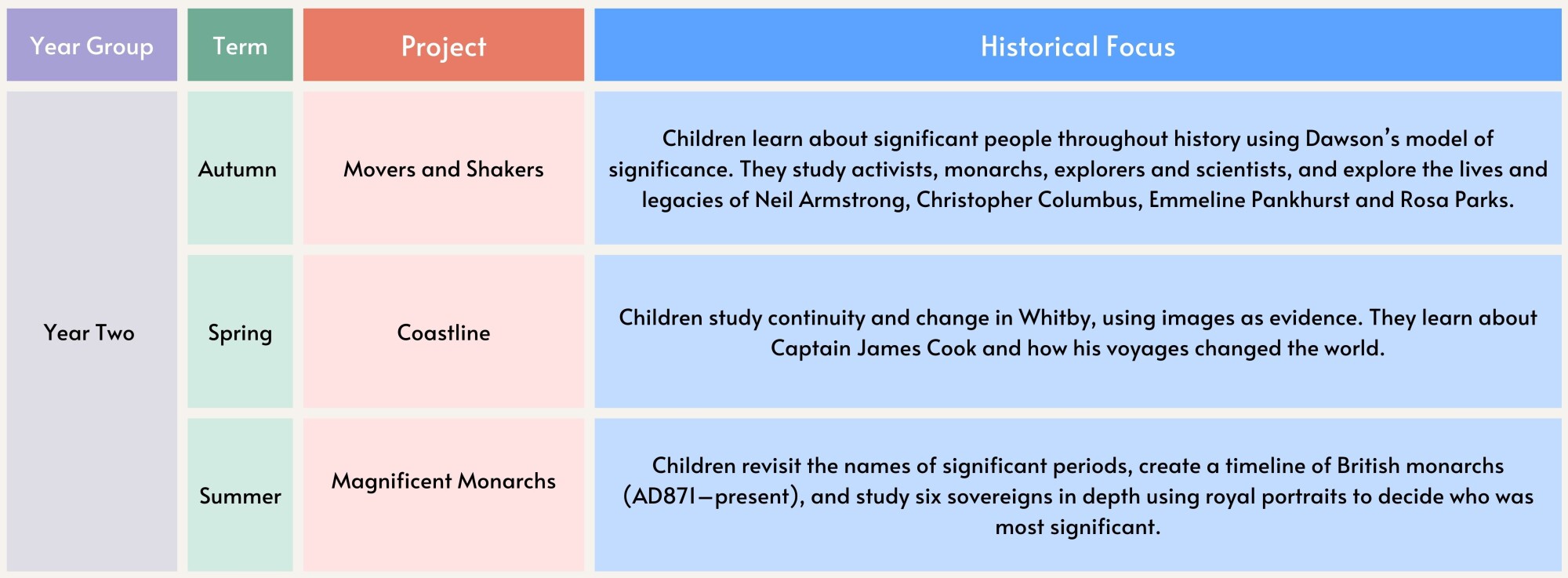History
Vision and Intent
At Kilnhurst St Thomas, we want history to truly come alive for every child. History should spark curiosity, ignite imagination and help children make sense of the world they live in today. Our aim is for pupils to leave us with secure knowledge and, most importantly, with the confidence to ask thoughtful questions, think critically and value the stories, struggles and achievements that have shaped both our community and the wider world.
We encourage children to think like historians: to be curious, to investigate carefully, to question ideas and to make meaningful connections. By exploring both the history of Kilnhurst and the rich diversity of Britain and beyond, our children develop not only knowledge, but also empathy, identity and a deep sense of belonging.
Our Curriculum Journey
At Kilnhurst St Thomas, our history curriculum takes children on an exciting journey through time, gradually widening their horizons as they grow. Each stage of learning builds carefully on what has come before, so that knowledge, skills and vocabulary are revisited, strengthened and deepened. This ensures that every child develops both confidence and curiosity as they grow into young historians.
Early Years
In the Early Years, we lay the foundations for historical learning by helping children talk about past and present, recognise change and compare family traditions and experiences. Through rich and engaging themes such as family life, special times, traditional tales, local community stories, farming, the seaside and the wonders of nighttime, children begin to notice how things change over time and explore the connections between their own lives and those of others. They discover that stories, traditions and events connect us to a wider world beyond their own experiences. These playful early opportunities spark curiosity, build a sense of time and place, and provide the essential foundations for the historical knowledge and enquiry skills that will grow in Key Stage One and beyond.
Key Stage One
In Key Stage One, children begin to look beyond their own experiences, exploring events beyond living memory and meeting significant individuals who shaped the past. They learn about important moments such as the Great Fire of London and encounter inspiring figures like Florence Nightingale and Mary Seacole, as well as explorers who helped us understand the world in new ways. Local history is also introduced, giving children the chance to connect the past to their own community of Kilnhurst. These rich and meaningful themes encourage children to ask questions such as “Why do we still remember the Great Fire of London?” and “How did Florence Nightingale change hospitals?”, beginning to build the enquiry skills they will need for deeper study in Key Stage Two.
Lower Key Stage Two
In Years 3 and 4, children step back thousands of years to explore fascinating early civilisations and discover how they shaped life in Britain. They journey through the Stone Age to the Iron Age, uncover the lasting influence of the Romans, and dive into the dramatic stories of the Anglo-Saxons, Vikings and Ancient Egyptians. Along the way, children strengthen their sense of chronology, beginning to see how different periods connect and build on one another, and how Britain’s history links with that of the wider world.
Upper Key Stage Two
In Years 5 and 6, children explore some of the most exciting and thought-provoking periods in history. They investigate the achievements of Ancient Greece and the complexity of the Mayan civilisation, before moving into more modern times with the Industrial Revolution, Victorian Britain, World War II and post-war Britain. At this stage, pupils deepen their understanding of cause and consequence, continuity and change, significance and interpretation, making thoughtful connections across different eras. By the end of Key Stage Two, children can reflect on how history has shaped the world they know today, leaving St Thomas with curiosity, confidence and a lifelong love of history.
Developing Historical Skills Across the Primary Years
History from EYFS to Year 6
Inclusion and Support
At Kilnhurst St Thomas, history truly belongs to every child. We want all pupils, including those with SEND and those who are disadvantaged, to feel included, confident and successful.
At St Thomas, history truly belongs to every child. We want all pupils, including those with SEND and those who are disadvantaged, to feel included, confident and successful.
- Making learning accessible – We bring history to life through pictures, timelines, storytelling and drama, helping every child to make sense of the past.
- Adapting for success – Activities are shaped around individual needs, with extra support when it is needed and challenge when children are ready to go further.
- Celebrating small steps – Every bit of progress is noticed and valued, showing each child’s unique journey.
- Seeing themselves in history – Our curriculum shines a light on a range of voices, cultures and stories so that all children feel represented in what they learn.
Celebration and Enrichment
We love making history magical, memorable and something children talk about long after the lesson ends.
- Classrooms alive with history – Displays, timelines and children’s own work make history part of the everyday environment.
- Stepping into the story – Theme days and role play give children the chance to experience what it might have been like to live in another time.
- Learning beyond the classroom – Trips to castles, museums and local sites, along with visits from experts, make history real and exciting.
- Sharing with families – Parents are welcomed into exhibitions, workshops and assemblies, sharing the pride children feel in their learning.
- Whole school moments – Assemblies and special events bring us together to celebrate history as a community, connecting the past to our Christian values.








